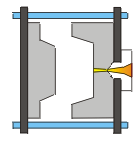Fast Way of Making Aluminum Auto Parts. Aluminum has a very unique property. This metal alloy is very strong and durable. Some even compares its strength to steel. Surprisingly, aluminum is very light for it strength and durability. Because of …
Continue reading
Category Archives: Diecasting Process
Hot Chamber And Cold Chamber Die Casting
Hot Chamber And Cold Chamber Die Casting. In the method of die casting, melted metal in injected effectively into die casting molds, or “dies”, under very high pressure. Since this process of shaping metal is very adaptable, die casting is extensively utilized as a method for forming metals into special shapes like die cast speakers. While it may use a almost the same method as mold casting, die casting uses pressures of up to 10 to 210mpa to inject metal into the die. The ensuing material shows consistency of parts, dimensional accuracy, and smooth surface finishes.
There are many diverse materials utilized in die casting, such as copper, zinc, tin, magnesium, and lead. Nevertheless, aluminum is the most extensively uzilized evaluated to these other materials as the metal is more impressionable, and is excellent for manufacturing large size cold chamber die castings, to die castings collected of tiny and intricate parts.
There are two methods utilized for die casting, specifically the cold chamber which manufacture cold chamber die castings, a cold cylinder is injected with melted metal. With less time exposure given for the metal to be pushed into the mold, cold chamber method is more often utilized for metals that without difficulty meld with iron at very high heat. The cold chamber method is also utilized for metals that have high melting points.
Alternatively, in the hot chamber process, like hot chamber zinc die casting the pressure found in the die cavity connected to it becomes enduringly a part of the melted material. A plunger is driven toward an area that is non-pressurized, exposing the inlet port attached to the pressure cylinder.
Kinetic Die Casting manufactures custom metal parts to their customer. If you would like more information about Kinetic Die Casting, please visit our website:Kinetic Die Casting Company
An Overview of Cold Chamber Die Castings
An Overview of Cold Chamber Die Castings. There are numerous methods that the metals have to travel through when they are being utilized in die casting, including cold chamber die castings. If you are new with the whole idea, you must first be informed about the major procedure before you dig further about expressions such as cold chamber die castings.
If you have not heard yet, die casting is well-liked in the metalworking industry for manufacturing lots of mass produced products in such department. Numerous sectors gain from this arrival counting the customer, commercial and industrial products. The integral die cast parts are typically incorporated into aluminum auto parts and aluminum aircraft parts, connectors that are being utilized in building homes, sink faucet, aluminum heatsinks, toys and much more.
Die casting employs an adaptable process that force liquefied metal into steel molds or the dies that are recyclable. This is achieved under high pressure. Through this, intricate shapes are being shaped, which strength and repeatability depend on which type of alloy was utilized in the development. These are some of the alloys that are generally exploited in die castings.
Zinc is said to be the simplest to cast. Aluminum is known for being lightweight and as to having great mechanical properties. Magnesium die casting is the simplest one to machine. Copper is known for its rigidity. Lead and tin are acknowledged for having high density.
Cold chamber die castings are machines that utilize alloys that have high melting points. An awesome example of this is aluminum. Once melted, the metal is placed into the cold chamber. This is also recognized as cylindrical sleeve. This can be poured in by hand with a hand ladle or through the use of automatic ladle. The port of the cold chamber is sealed by a plunger that is hydraulically operated. This forces the metal into the die which is held at tremendous pressures.
Kinetic Die Casting Company can manufacture aluminum car parts, aluminum hardware, and Aluminum Lighting Partsaluminum lighting parts
The Die Casting Part Production Process Explained.
What is the Die Casting Process? The Die Casting Part Production Process Explained.
Kinetic Die Casting Company uses a manufacturing process called “Die Casting” to make aluminum die casting parts and zinc die casting parts. But, what is the die casting part production process? Here is a GIF image I have on our home page to demonstrate:

demonstration of the die casting process
“Aluminum die casting is an aluminum metal parts production process where molten aluminum metal alloy is injected into a steel die, under extreme pressure, to manufacture aluminum parts” (Substitute the word “zinc” for “aluminum” in zinc die casting part production process)
Another GIF example example is on this web page:
(click) What is Die Casting?
Another demonstration of the die casting process

Cold Chamber Die Casting Process
The image pictured above depicts a Cold Chamber Die Casting Machine as it makes parts. The term “Cold Chamber Die Casting” refers to a separate metal melting furnace. The High Pressure Die Casting, cold chamber die casting process follows this sequence:
- Look at the die casting machine image above
- The die casting machine opens the die casting mold.
- The prior part is removed and the die cast mold is sprayed for the next part
- The aluminum is poured using a ladle into a shot cylinder
- The shot piston injects the metal into the die casting mold.
- The machine opens and the process starts again.
Contact Kinetic Die Casting Company for more information about the high pressure die casting process and about how to get great die casting parts at a great price and delivered quickly, no matter what quantity you need.
Kinetic Die Casting manufactures aluminum military parts, aluminum hardware, and aluminum die castings. Visit our website for a quote: Kinetic Die Casting Company
Die Casting
Die Casting. Die casting is a very ordinary method of producing metal parts. In the method of high pressure die casting, melted metal alloy such as aluminum alloy is inserted into a mold called a die like zinc die cast tooling. The metal is left in the steel mold until it hardens and then it is detached.
There are two types of machines that are utilized in die casting. First is the hot chamber machine, also called piston or gooseneck machine, and the second is the cold chamber machine. The hot chamber machine has the metal injection device, or gooseneck, submerged in the melted metal within the holding furnace. This machine works by having the gas or oil-powered piston retracted and allowing the melted metal to fill the gooseneck. The melted metal is then forced out of the gooseneck by the piston and the metal goes into the die. Not all metal alloys can be utilized in the hot chamber machine. Due to this, cold chamber die castings must be made. Aluminum and metals with high melting points like copper, magnesium, and zinc alloys require the cold chamber machine. The cold chamber machine does not have the piston absorbed in the melted metal. Before utilizing the cold chamber machine, the metal must be liquefied first in a disconnected furnace. Then the liquefied metal is brought to the cold chamber machine and injected into a cylinder and a hydraulic piston forces the metal into the die. Cold chamber die castings take longer to manufacture because the metal has to be melted in an separate furnace.
It doesn’t matter whether parts are hot chamber or cold chamber die castings. Both these products are completed using the magnificent manufacturing method known as die casting. Therefore, you will have products such as die cast speaker, aluminum die cast boxes, and aluminum heatsinks.
Kinetic Die Casting manufactures aluminum and zinc die casting parts. Samples of KDC’s work include die cast speaker parts, aluminum tile plates, and other die cast metal parts. If you would like to have a quote please visit our website: Kinetic Die Casting Company
The Pros and Cons of Cold Chamber Die Castings
The Pros and Cons of Cold Chamber Die Castings. Cold chamber die castings utilize Cold Chamber machines to make easy die castings. Cold chamber die casting is one of the two die casting methods. The other one is Hot Chamber castings which sometimes utilizes Hot Chamber zinc castings.
Cold chamber die castings engage the utilize of a metal cylinder where the melted metal alloy is poured. The melted metal then will be pushed by an injection pump into the die cast thus manufactured metallic parts.
Cold chamber die castings allow for the manufacturing of aluminum, zinc, and certain alloys of magnesium. In fact, these outstanding materials for fabricating parts can only use cold chamber die casting methods.
The huge benefit of cold chamber die castings is that the process can make denser metal castings. Denser metal is fashioned owing to the higher pressure utilized during the injection development. Density can also be qualified to higher speed procedure of cold chamber injection. Another benefit of cold chamber die cast manufacturing is its low maintenance cost. Through cold chamber castings, manufacturers can produce more parts with lower overhead costs. This drives down the market prices of aluminum parts.
Cold chamber die castings also have several disadvantages. First, cold chamber manufacturing has slower production cycles. The melted metal in the cold chamber can cool down even before injection. Finally, the melted metal in the cold chamber is barer to oxidation and other contaminants chiefly if the production floor does not have strict quality control.
Cold chamber die castings can offer many advantages for die cast parts manufacturers. The benefits and advantages one can get from the cold chamber method can outweigh its disadvantages. Metals used in cold and hot chamber methods include 380 Aluminum, zinc, and other aluminum alloys.
Kinetic Die Casting is a die casting company specializing in aluminum and zinc parts. If you would like to request a quote, please visit our website:Kinetic Die Casting Company

